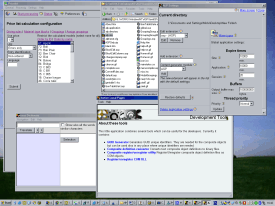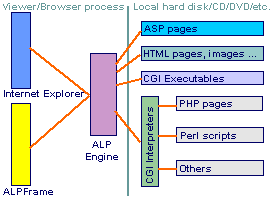 What
is ALP?
What
is ALP?
Active Local Pages combines the power of WEB programming and desktop
programming in one. Without need of anything else than Microsoft Internet
Explorer® installed on the machine ALP can power wide range of applications
built for it or ported from Microsoft Internet Information Server® and run them
not depending on any network functionality, server software and administrator
efforts. The applications for ALP are written just like WEB applications,
but they run as desktop applications. Still, ALP is not a WEB server, it is not
disturbed by firewalls, it does not require users or administrators to perform
configuration tasks..
Programs powered by ALP
ALP is best for personal and business DB (data base) applications,
productivity and informational tools, encyclopedias, dictionaries, catalogs, PC
management tools, organizer software, business tasks automation and many others.
The ALP programming interface resembles and is compatible with popular WEB
programming techniques and many applications built for WEB servers will also run
on ALP as desktop applications with none or only cosmetic adjustments.
Application's Look-And-Feel may vary from typical WEB-like user interface to
typical Windows application interface. The developers may choose between
Microsoft Internet Explorer® or ALPFrame browser as their application front-end
and thus benefit of typical WEB page look-and-feel (IE) or combine WEB and
typical Windows application user interface features (ALPFrame) - whichever is
best for every particular project.
Is ALP right for me and my company?
Most likely yes. In many areas ALP is easier to use as platform than a
typical form-based Rapid Application Development environment. ALP offers more
flexibility than the most development environments and is simple enough even for
beginners. ALP ships with Run-time library that allows the developers access
wide range of features and tools relying only on ALP's own components, but ALP
is also open environment and the applications for it can integrate with almost
any other known Windows software or use alternative components from other
vendors. The ALP's own components depend on nothing else than IE and the
applications for ALP can be built to run on any Windows system not depriving
them of features such as SQL database functionality, networking, powerful file
access mechanisms and many others. On the other hand ALP applications can be
built to cooperate or integrate with the other software you already run to
extend your IT infrastructure. Thus the ALP applications can serve both - be a
part of your office/organization infrastructure or be as independent as
theoretically possible and deploy easily on any Windows machine.
 So,
how ALP works?
So,
how ALP works?
ALP implements WEB programming interfaces compatible with Active Server Pages
(ASP compatible pages) and CGI (Common Gateway Interface) from which ASP is the
primary programming interface for ALP. ALPFrame browser/viewer (mentioned above)
is based on Microsoft Internet Explorer® but extends its DHTML programming
model with window and context menus, advanced application window control and
more. You can think of it as of a 'browser' designed in a bit different way -
its look and user interface details are dynamic and fully controllable by the
application in contrast to the traditional WEB browsers. That is why it has no
substantial default user interface elements - the applications create and show
them as they need them.
ALP engine consist of a core DLL and module DLL. They load into the browser
process whenever an ALP URL is requested and they fetch/execute the resources
from your local storage drives. WEB servers do this on a server and
receive/respond to requests from the browser through TCP/IP. ALP, in contrast,
does this directly. The functional effect is like you have an embedded
WEB server in the running browser (IE or ALPFrame) instance. ALP supports
directly ASP and CGI (with some limitations) and through CGI interpreters many
other programming interfaces. The visual enhancements based on the ALPFrame
features are completely DHTML (browser side) controlled, therefore they can be
used from any application no matter what programming interface is used.
Various highlights
The software developers can employ their existing skills in WEB
software development areas in totally new area - desktop software, autorun
aplications (on CDs, flash memory and other removable media), combined
desktop/online applications. As long as it makes sense you can just get one
of your online applications and adjust it to run under ALP and then
distribute it to the users. You can write code that will run on stand-alone
PCs and WEB server without changes. Even without these benefits many people
will agree that WEB programming (ASP pages for example) is much easier than a
typical RAD tool (form based for example) for quite many applications. ALP
needs very little in order to run you will discover that an ALP applications
will need re-distributable files much less in size and much less troublesome on
the various Windows versions. Through COM you can use almost any available
ActiveX built for ASP pages and thus you have access to a huge library of
additional components from many different vendors that may help you add
almost any imaginable feature in your application. The COM interface allows also
the ALP based projects gain access to the other applications on the system -
they can cooperate with MS Office applications, local and intranet database and
application servers, perform tasks that are part of the entire information flow
in your organization.
With the autorun support you can adapt or write many applications to run just
from a CD/DVD or a flash memory card/drive without initial setup. Active Local
Pages ships with a very advanced run-time library (known also as newObjects
ActiveX pack1 family) which gives you ability to rely on ALP base components
for wide variety of tasks and thus avoid any additional dependencies that may
rise the size and complexity of the redistribution packages. Through this
library you have access to many system features otherwise known to be accessible
only for C++ or Delphi applications - for example you can even run threads in
the background and communicate with them asynchronously from your front ASP
pages.
How hard is it to write something in ALP? If you have WEB programming skills
in ASP or CGI you do not have much to learn in order to begin. Of course, you
must get used with the ALP specific features, get used to the way the
applications are distributed (for example, in contrast with a WEB server you
must take care to redistribute the 3-d party components if you use such).
However, an ASP developer will find ALP very close to the classic ASP and most
of the differences are obvious consequence of the fact that the ALP applications
run locally and not on a server - something you can guess even before reading
about it in the documentation.
End-users. You may even already have some ALP applications and not
know about them. There are two general types of software consuming schemes:
Obtaining software that is built and exposed/sold to anyone who may need it and
Ordering software development of specific application(s) you or your
organization needs for internal usage or wants to distribute or sell.
In the first case you can download ALP applications and you will need the ALP
engine to run them. They may have it embedded in their redistribution package or
my be packed without it to reduce the download size. In the second case you may
consider ALP as cost effective way to create and use software tools for your
business. If it is small you need just a few cheap ALP LOCAL (per-seat) licenses
for your workstations, if you want to build software for the market you buy
DEVELOPER license once and there are no additional fees - not based on
development workstations, nor based on the number of the applications, nor based
on the way and volume of the distributed packages!
How much it costs?
newObejcts Active Local Pages is licensed in very simple manner. There
are two base license types only.
First there is a per-seat based license which is referred as LOCAL
license through the documentation. It licenses ALP engine for one machine to run
any compatible application. It is NOT a re-distribution license. It is mostly
for small companies and individuals who need full freedom to run anything on
their machines. The license permits you install ALP not only on a single PC, but
also on all the personal devices you use beside it - such as laptop or PDA (when
the PDA version becomes available).
The DEVELOPER license is for re-distribution of applications with ALP
(or without it - any suitable way the developer may choose). It is embedded in
the applications so the end-users do not need to obtain LOCAL license in order
to use the application - no matter if the application is packed with ALP engine
or ALP is downloaded separately. It applies and travels only with the
applications in which it is embedded. One developer license allows any number of
different applications to be built and re-distributed as appropriate on behalf
the developer (company/organization/individual) who owns the license. This, of
course, includes in-door usage of such applications in your organization.
Read more about the licensing and the prices on the Buy
ALP page.
We aim at a simple licensing scheme which will not involve the developers in
boring licensing arrangements each time they need to extend their business. We
hope this saves your time and our time for much better purposes ;).